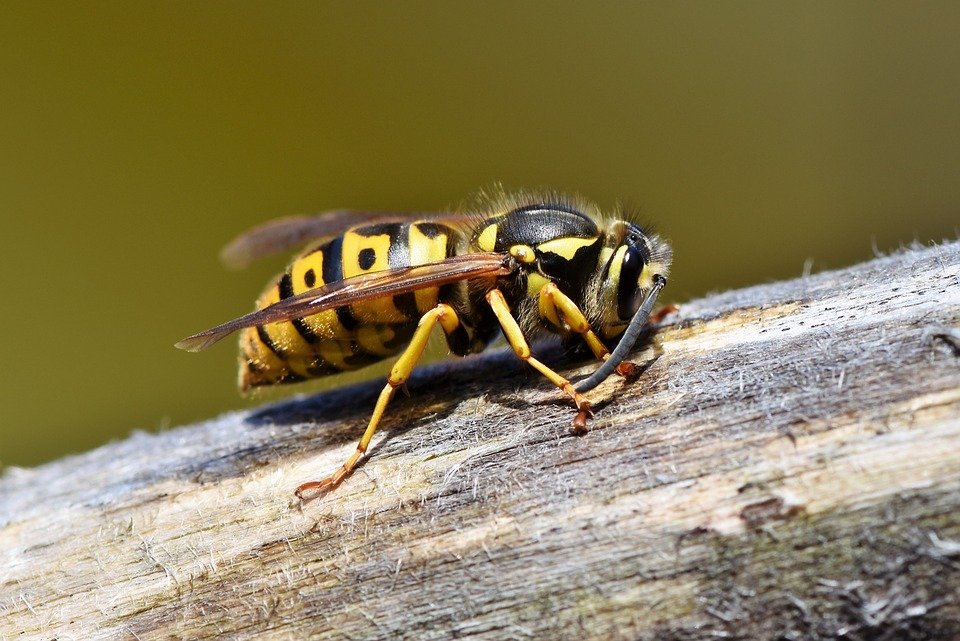Professional Wasp Treatment
Wasp Exterminator Chicago
Wasp extermination in Chicago IL is available 7 days a week / 365 days a year. ATAP pest control provides effective wasp extermination quote solutions to eradicate these insects at the nests and eliminate them from your home or office from Paper wasp to Great Black Wasp. Our expert Chicagoland wasp exterminators are trained and experienced to inspect, control, and remove wasps from your property. Our prices are great and the control service is quality! Get a quote now!
Free Wasp Extermination Quote
Pest Control and Wasp Removal in Illinois
You don’t have to tolerate wasps. Call us and request a free phone consultation for the right wasp extermination treatment for you. An insect problem demands immediate action. Waiting for it to go away, or trying to get rid of it yourself, could be hazardous for you and your family. At ATAP Exterminators, we take an approach to wasp extermination that will solve your issues quickly – and in a way that is safe for you, your family, and your pets.

We don’t like to brag, but you want to get a quote from us. Why? We control the Wasp problem quickly. It is our speciality. When wasps see our truck, they run to your neighbor’s house 🙂 Matter of fact, if you said our name out loud to request a quote, they are terrified and packing their bags right now. We’ve been providing protection in homes for years. Call the best in the city, ATAP pest control.
Innovative Equipment
We use the newest and most effective equipment for pest control services.
Focused Service
We specialize in wasp control service, pest control and pest control treatment services for your home and your commercial property. Pest control for wasps, we can do it in our sleep! Trust our wasp control services experts.
Clients share their experience with Our Wasp Treatments



Need Our wasp Control Service in Chicago IL? Please call us:
We would love to see how we can solve your pest control problem. Find and Call today!
- Chicago Southside Pest Control Exterminator
- Crete, IL Pest Control Exterminator
- Frankfort, IL Affordable Pest Control
- Homer Glen, IL Exterminator Near Me
- Homewood, IL Pest Control Services Near Me
- Lansing, IL Pest Control Services Near Me
- Matteson, IL Exterminator Near Me
- Monee, IL Affordable Pest Control
- New Lenox, IL Exterminator Near Me
- Orland Park, IL Exterminator Near Me
- Pest Control Country Club Hills
- Pest Control Flossmoor
- Pest Control Hazel Crest
- Pest Control Homewood
- Pest Control Olympia Fields
- Pest Control Park Forest
- Richton Park, IL Affordable Pest Control
- South Chicago Heights, IL Pest Control Exterminator
- South Holland, IL Pest Control Exterminator
- Tinley Park, IL Pest Control Services Near Me
(773) 701-7705
Wasp Exterminator In Chicago
As the weather warms, wasps and other stinging insects become more aggressive. You’ve most likely discovered a wasp nest on or near your property, which is why you’ve arrived at this page to learn about treatment options.
If you have an active wasp nest, you can be certain that it will develop if you leave it alone. Wasps, as you may know, can be extremely aggressive when provoked. As a result, Wasp Exterminator I prefer to ignore them.
Wasps, you see, don’t always know where the disturbance is coming from. A wasp, on the other hand, will take flight if it is disturbed. You could be the victim, or it could be a small child playing in the yard innocently. You are correct in thinking about wasp removal.
A large number of people are allergic to wasp stings. Some people’s allergies are so severe that if they are stung, they require immediate medical attention. If the allergy is already known, the reaction is treated with an EpiPen.
Wasp nest removal in Illinois is best left to the experts. Most people’s fear of being stung by a wasp is what causes them to be injured when attempting to remove it.
Accidents caused by attempting to remove a wasp nest include: falling off a ladder, colliding with bystanders while fleeing, and, of course, being stung.
Too many stings can overwhelm a healthy person’s immune system, causing serious illness or even death.
That is why it is critical to hire a trained wasp removal technician. We have been doing pest control in the area for over 15 years. We’ve helped thousands of people with pest problems, including wasp removal, and I’m confident we can help you as well. For the best exterminators in Chicago, call (773) 701-7705 or use the contact form on the right side of this page!

Wasps and Their Importance
Wasps are essential to the natural environment and are at their peak during the summer months. Wasps eat arachnids and a variety of bug bugs, such as ants and caterpillars, by laying their eggs on or inside other pests or spiders, which are then consumed by newly hatched wasp larvae. Wasps, like bees, aid in the pollination of plants. April is the month when young queen wasps awaken from their winter hibernation and begin to build nests out of chewed-up wood fibers mixed with saliva. The queen is in charge of the nest, which is populated by workers hatching from eggs she fertilized with sperm she collected the previous fall.
In May, the queen continues to lay eggs in individual cells, which hatch into larvae that are fed pests by worker wasps. The second group of hatched larvae pupates into adult workers during the first part of the month. Throughout the rest of the summer, this procedure will be repeated on a regular basis. By the end of May, the first workers have been joined by dozens of others who help build the nest and care for the larvae. The wasp nest reaches peak activity levels in June and July, and the nest continues to grow in size. By July, hundreds of wasps had been raised to adulthood in the nest, and hundreds more were either resting in their eggs or had recently hatched.
During the months of August, September, and October, wasp activity begins to slow, with employees dying and the queen reducing her egg-laying. During these months, she lays eggs that hatch into fertile males and females, as opposed to the sterile female workers she previously hatched. During this time, the queen dies, and the young queens mate with the fertile males and fly away. The last to die are the fertile males.
If you’re seeing wasps a lot more now that it’s summer, we have some good news and some bad news for you. First and foremost, we’ll address the issue. If you see a lot of wasps on your property today, it’s probably because they built a nest nearby. Fortunately, there is something you can do about it. Wasp Removal and Control! Here’s everything you need to know about the wasps you’ve been encountering this summer. You can keep the venomous stingers of summer at bay much more effectively if you understand what makes them tick. Every year in the spring, queen wasps return to their overwintering sites in search of new nesting sites.
When the wasp queen finds an appropriate nest, she begins laying eggs in order to establish a new colony. When these eggs hatch, the resulting workers construct the nest while the queen continues to reproduce and replicate. Wasp colonies have reached their peak population by the summer season. Hundreds to thousands of worker wasps populate a nest and spend their entire day searching for food to feed their young. Naturally, the greater the wasp population, the more wasps you are likely to encounter. In other words, it’s not those wasps are always more active in the summer; it’s just that there are more of them. Fortunately, wasps don’t usually stray far from their nests during the summer.
Wasp Extermination & Control – Where Do Wasps Build Their Nests?
Wasps frequently build nests near or on houses because they meet wasp nest requirements. Wasps, for starters, require a location where their nest is inaccessible to predators. Wasp nests are frequently found on eaves, overhanging parts of roofing systems, high corners, and even in chimneys. Wasps, on the other hand, can hang their nests from almost any base, so any high, difficult-to-reach area will suffice. Wasps require building materials and a food source near their nests, in addition to a remote location. Workers use wood fiber to construct and expand their nests. They break down weathered wood fiber, mix it with saliva to make a pulp, and then use that pulp to build the nest.
It is difficult to remove honey bees once they have settled into a structure or tree. The earlier you call, the better! Swarms are normally quite friendly, but if you try to eliminate them, they will turn on you and sting you. On-surface swarm removal is, for the most part, completely free. I might charge a small travel fee to help cover expenses and allow me to use a $3M liability insurance policy to cover any mishap that has never occurred before.
This has the greatest impact on bee removal costs. The easier it is for an insect control professional to get to the bees, the less expensive the job. Similarly, if the bees are difficult to reach, such as high up in a tree, behind siding, or hidden in an attic, the price will rise. Understand that bees in the structure of a house may be considered a health and wellness issue by regional laws.
The cost of bee effects can be calculated in a variety of ways, beginning with where each bee chooses to live. Honey bees prefer to build hives in or on structures, such as your house or a tree in your yard. Carpenter bees burrow into wood, whereas bumble bees prefer to nest in the ground. Because of where they nest, some people confuse bees with wasps or hornets.
Seeing honey bees buzzing around your home to make contact can be concerning. The presence of fuzzy little black-and-yellow striped bumble bees in your garden is not a problem; however, if you see others around your wood structures, they could be carpenter bees, which you do not want to have contact with your property and must be controlled. It can be dangerous to try removal services or transfer bees on your own, and you never want to inadvertently harm a honey bee.
A dependable honeybee, wasp, or hornet removal necessitates drawing them out of the local structure with comb and honey and then protecting the area (for bees). This information will reduce the likelihood of contact with other pest species in the pest library, such as moths or mice, that infest vacant combs, as well as avoid re-infestation. When the cavity is removed, it is rendered uninhabitable to future nests from the inside.
Frequently, you will be given a written guarantee against re-infestation in the exact same location. Outside cracks are filled with latex, paintable caulk. As a beekeeper, I will relocate and re-establish the colony to help preserve the population in the Chicago area.
Typically, your elimination is completed and the structure is sealed on the same day. In many cases, honeybees must be released to re-group. They are later eliminated as a group because they require more than one journey. Our wasp and bee specialists work with you to determine the best options and requirements for your specific situation.



